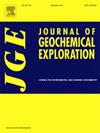Host minerals of lithium in Jiujialu Formation Li–rich claystones in South China, and implications for the genesis
IF 3.3
2区 地球科学
Q1 GEOCHEMISTRY & GEOPHYSICS
引用次数: 0
Abstract
Lithium is a critical metal, and recent discoveries have identified significant lithium enrichment in the Late Paleozoic Jiujialu Formation (C1jj) of southwestern China. However, the specific mineral hosts of lithium remain a topic of debate. This study examines two representative sections of the Jiujialu Formation, utilizing major and trace element analysis, δ7Li, SEM-EDS, and XRD techniques. However, previous TOF-SIMS studies have shown that lithium is not enriched in K-rich illite. Furthermore, ion exchange experiments indicate that approximately 6 % of lithium can be exchanged by Na+. This finding, combined with δ7Li values, XRD patterns, and SEM–EDS data, supports further interpretation. In conjunction with a review of previous research on the formation and transformation of clay minerals, this study suggests that lithium is predominantly hosted in the smectite crystal lattice of illite-smectite mixed layers. It proposes a two-stage diagenetic process for the formation of lithium-rich claystones: the first stage involves the formation of lithium-rich smectite, and the second stage entails the transformation of this smectite into illite and chlorite during diagenesis. In the first stage, weathering of argillaceous dolomite created an alkaline, stagnant, and closed sedimentary environment that facilitated the formation of lithium-rich smectite. In the second stage, lithium-rich smectite, as a precursor, undergoes illitization and chloritization. While illitization leads to the formation of stable illite-smectite mixed layers, chloritization of smectite is less likely to form stable chlorite-smectite mixed layers. Consequently, claystones with higher illite content tend to have higher lithium concentrations. Furthermore, complete illitization and chloritization result in the formation of low-lithium claystones. This study resolves discrepancies in previous research and provides a new perspective on the relationship between the diagenetic processes of lithium-rich claystones and the variations in lithium content.
华南九家路组富锂粘土岩中锂的寄主矿物及其成因意义
锂是一种重要的金属,近年来在中国西南地区晚古生代九家路组(C1jj)发现了明显的锂富集。然而,锂的具体矿物宿主仍然是一个有争议的话题。本研究利用主微量元素分析、δ7Li、SEM-EDS和XRD等技术对九家麓组的两个代表性剖面进行了研究。然而,之前的TOF-SIMS研究表明,锂在富钾伊利石中并不富集。此外,离子交换实验表明,约6%的锂可以被Na+交换。这一发现,结合δ7Li值,XRD模式和SEM-EDS数据,支持进一步的解释。结合前人对粘土矿物形成和转化的研究,本研究认为锂主要赋存于伊利—蒙脱石混合层的蒙脱石晶格中。提出了富锂粘土形成的两阶段成岩过程:第一阶段是富锂蒙脱石的形成,第二阶段是在成岩作用中蒙脱石转变为伊利石和绿泥石。第一阶段,泥质白云岩风化形成碱性、停滞、封闭的沉积环境,有利于富锂蒙脱石的形成。在第二阶段,富锂蒙脱石作为前驱体,经历了伊利石化和绿泥石化。伊利石作用可形成稳定的伊利石-蒙脱石混合层,而蒙脱石的绿泥石作用则不太可能形成稳定的绿泥石-蒙脱石混合层。因此,伊利石含量高的粘土具有较高的锂浓度。此外,完全的illiization和chlor泥化作用导致低锂粘土的形成。该研究解决了前人研究的差异,为富锂粘土岩成岩过程与锂含量变化之间的关系提供了新的视角。
本文章由计算机程序翻译,如有差异,请以英文原文为准。
求助全文
约1分钟内获得全文
求助全文
来源期刊

Journal of Geochemical Exploration
地学-地球化学与地球物理
CiteScore
7.40
自引率
7.70%
发文量
148
审稿时长
8.1 months
期刊介绍:
Journal of Geochemical Exploration is mostly dedicated to publication of original studies in exploration and environmental geochemistry and related topics.
Contributions considered of prevalent interest for the journal include researches based on the application of innovative methods to:
define the genesis and the evolution of mineral deposits including transfer of elements in large-scale mineralized areas.
analyze complex systems at the boundaries between bio-geochemistry, metal transport and mineral accumulation.
evaluate effects of historical mining activities on the surface environment.
trace pollutant sources and define their fate and transport models in the near-surface and surface environments involving solid, fluid and aerial matrices.
assess and quantify natural and technogenic radioactivity in the environment.
determine geochemical anomalies and set baseline reference values using compositional data analysis, multivariate statistics and geo-spatial analysis.
assess the impacts of anthropogenic contamination on ecosystems and human health at local and regional scale to prioritize and classify risks through deterministic and stochastic approaches.
Papers dedicated to the presentation of newly developed methods in analytical geochemistry to be applied in the field or in laboratory are also within the topics of interest for the journal.
 求助内容:
求助内容: 应助结果提醒方式:
应助结果提醒方式:


